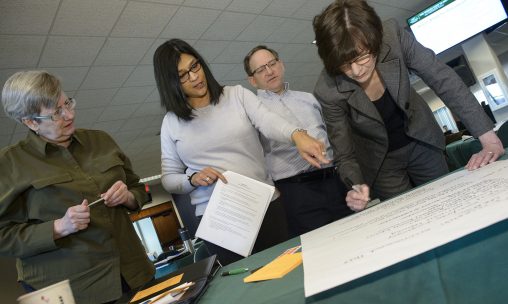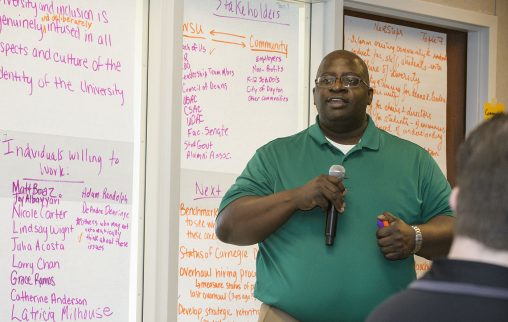
More than 100 Wright State faculty, staff, administrators, students, alumni and community partners participated in a stakeholder summit, proposing possible action items for the university’s strategic plan. (Photos by Erin Pence and Chris Snyder)
Enriching the student-centered experience; focusing on research and scholarly activities; expanding experiential and online learning; breaking down silos; ensuring diversity and inclusion are infused into the culture — these were just a few of the areas participants of the strategic planning summit said Wright State University should prioritize.
Summit participants identified the community’s cores values, brainstormed new university mission statements, recognized areas they think are institutional strengths and dreamed of projects Wright State could undertake in the future.
More than 100 Wright State faculty, staff, administrators, students, alumni and community partners participated in the stakeholder summit on March 20–22.
Participants worked in small groups, creating an energetic buzz of intense, thoughtful conversations throughout the room as they shared stories and brainstormed ideas. When they reported on their discussions to the full summit, participants often cheered when they identified their tables, eliciting laughs and more cheers.
By the end of the summit, three walls of the meeting space at 2455 Presidential Drive were plastered with ideas and aspirations written on large flipcharts and brightly colored notecards.
The ideas, stories and input will be used to create action items and goals for the university’s new strategic plan, The Wright Path to 2025: Pride, Transformation, Potential.
David Bright, Strategic Planning Steering Committee co-chair, said the discussions held throughout the summit “allow us to co-create all of the elements of the strategic plan.”
“When we’re done, the strategic plan will be a collectively generated document,” he said.
President Cheryl B. Schrader described the summit as a tremendous experience. She said she was impressed with participants’ energy, passion and commitment to Wright State.
“I love this process because it highlights to everybody why I love the people of Wright State and this community,” she said.
The summit, Schrader said, will help build a bold and bright future. “I am very excited to see the possibilities, to chart where we are going, and then have that opportunity to work together to realize the dreams that we’ve identified,” she said.
The summit culminated with participants creating aspirational statements about action items that could be incorporated into the strategic plan. Example statements included:
- Research and scholarly activities: Develop a research environment that maximizes knowledge creation, dissemination and application regionally and globally.
- Inter-unit collaboration: Integrate processes for better communication between units and improved communication from the top on down and vice versa.
- Community/diversity: Genuinely and deliberately infuse diversity and inclusion in all aspects and culture of the university.
- Student life: Provide a student-centered experience that fosters innovation and inclusivity through our world-class facilities, programs and services that enhance and support the development of the whole person.
- Experiential learning: Guarantee that every student will participate in meaningful experiential learning.
- Curriculum development/course design: Work across disciplines to revamp the curriculum so that roadblocks are removed and graduation rates increase dramatically.
Summit organizers and participants developed these and other action areas and aspirational statements based on discussions, held over the first two days of the event, about Wright State’s values, strengths and opportunities.

The stakeholder summit culminated with participants creating aspirational statements about action items that could be incorporated into the strategic plan.
Collaboration, integrity, student-centric services and valuing each person were among the dozen values summit participants said they think are at the core of the Wright State community.
Nationally recognized programs and faculty, community engagement, customer service, the university’s culture and people, and accessibility and flexibility were among Wright State’s strengths identified by summit participants.
Participants also brainstormed new mission statements for the university. A few of the suggested mission statements included:
- Provide an accessible, affordable high-quality education to produce the diverse educated citizenry required to address the needs of our region, nation and world.
- Integrate learning, research and experience to educate and empower all students to maximize their full potential as visionary leaders and global citizens.
- Lead with integrity and innovation through effective collaboration across stakeholders to empower students to reach their goals and dreams and to transform the communities we serve.
In April, the Strategic Planning Steering Committee will host an event to unveil the updated vision, mission and values statements and a draft strategy statement.
The strategic planning process is intended to start an ongoing dialogue among the campus community that encourages continuous reflection and revision of the community’s hopes and priorities.
“We’re building relationships across the university and helping people connect with individuals they don’t know,” said Bright, who is chair of the Department of Management and International Business.
The strategic plan will guide Wright State by creating a vision and focus that directly aligns resources with the community’s values, strengths and the strategy built around them. The planning process will be continuous and will put Wright State in a position to thrive in higher education’s changing environment, help the university achieve financial sustainability and foster a campus atmosphere that provides graduates with opportunities to excel in fields that define the future.
The goal is to deliver a strategic plan to the Board of Trustees by October 2018 for its approval.
Schrader said the strategic plan will reflect “our shared priorities, our strengths and where we are going as a university.”
You can stay up to date with the planning process by visiting wright.edu/strategicplan.













 Milling around
Milling around  Wright State recognizes Nursing Professor Kim Ringo for advancing international student success
Wright State recognizes Nursing Professor Kim Ringo for advancing international student success  Wright State honors graduating students for distinguished doctoral dissertations
Wright State honors graduating students for distinguished doctoral dissertations  Top 10 Newsroom videos of 2025
Top 10 Newsroom videos of 2025  Museum-quality replica of historic Hawthorn Hill donated to Wright State
Museum-quality replica of historic Hawthorn Hill donated to Wright State 